$1 notes of the Banco de Zacatecas
by Dr. Luis M. Gómez Wulschner
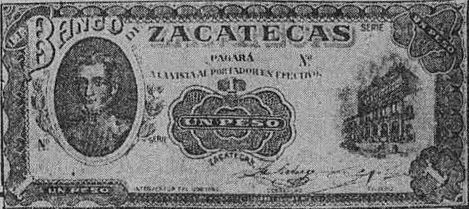
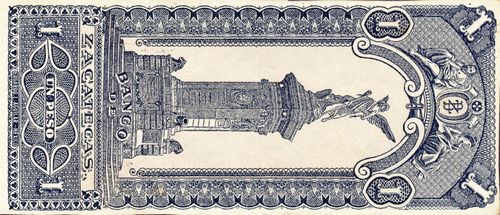
In 1914 the Banco de Zacatecas continued to operate in the state as well as in its branch offices in Lagos de Moreno, Jalisco and the city of Aguascalientes. Nonetheless, the members of the board of directors and the bank manager had moved to Mexico City in December of the previous year for security reasons.
Initially the board members met at the house of Antonio G. García at number 93, Avenida Juárez. Antonio G. García, José L. García, Enrique Aubert, Edmundo von Gehren, José L. del Hoyo and the bank manager, Elavio Macías attended these meetingsAGN, f Antiguos Bancos de Emisión, Zacatecas: Libro de Actas, fj, 2r. At one of these meetings it was agreed that if the city of Zacatecas was seriously threatened, the bank should be closed and transactions should be temporarily suspendedAGN, f Antiguos Bancos de Emisión, Zacatecas: Libro de Actas, fj, 3r.
The government of Victoriano Huerta, stifled with economic problems, allowed the issue of one and two peso notes, which had been forbidden by the Ley General of 1897. Nonetheless, at the meeting on 26 December 1913, the board of directors agreed not to issue one and two peso notes AGN, f Antiguos Bancos de Emisión, Zacatecas: Libro de Actas, fj, 2v. However, on [ ] they decided to release to circulation one hundred thousand one peso notes which the manager was authorized to order from the printer who offered the best terms in Mexico City AGN, f Antiguos Bancos de Emisión, Zacatecas: Libro de Actas, fj, 6r.This enterprise was Eduardo I. Aguilar whose establishment "Talleres de Grabado en Acero y Cobre" (Workshop of Engraving in Steel and Copper) was located at the fifth street of Bucareli # 116 (number 58 Regina is also mentioned).
Toward the end of May, Enrique Velasco, the bank accountant, came to Mexico City to inform the Board of the situation in Zacatecas, of the imminent attack by the revolutionary forces and, consequently, the possible danger to the employees and the interests of the bank. If the garrison was unable to resist the rebel forces the capture of the plaza would be fatal. On 2 June the Board unanimously agreed to close the main office temporarily and transport the portfolio, documents and accounting books to Mexico City. At the same time, a provisional office would be opened in Mexico City. It was also agreed to close the branch offices at Lagos de Moreno and Aguascalientes, and immediately notify the Ministry of the Treasury AGN, f Antiguos Bancos de Emisión, Zacatecas: Libro de Actas, fjs, 13r-13v .
The Board met again on the morning of 23 June when the fight for the capture of Zacatecas was beginning between the forces of Villa’s 'Dorados’ and the Federal Army. It was informed at that meeting that provisional offices had been opened at numbers 8 and 10 in the building of the Banco de Londres y México (at the corner of Bolivar and 16 de Septiembre) The main office and the branch offices were housed in these offices with the necessary personnel as well as the papers, documents and accounting books AGN, f Antiguos Bancos de Emisión, Zacatecas: Libro de Actas, fjs: 14r-14v.
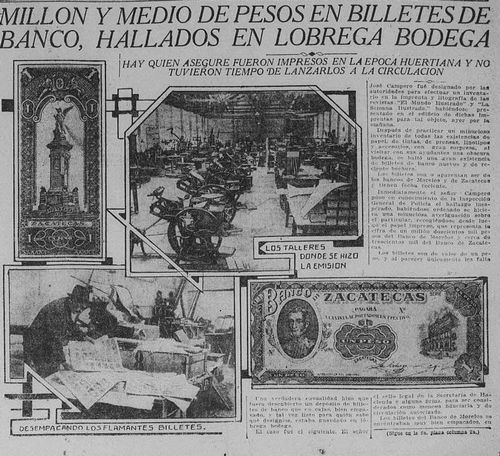
El Liberal, 29 September 1914
On 9 October the bank manager, Flavio Macias, informed the board that the Constitutionalist military authorities in Mexico City had confiscated the Eduardo Aguilar lithographic printshop. This was where the 150,000 one peso notes of the Bank of Zacatecas had been ordered: the unfinished notes were found lacking the stamp, the Interventor's signature, and the legal requisitioning by the corresponding office of the Ministry of the Treasury. This unexpected event would delay the delivery so the Board decided not to release these notes to circulation. Nonetheless, they would do all in their power to assure their recoveryAGN, f Antiguos Bancos de Emisión, Zacatecas: Libro de Actas, fjs, 17r-17v .
Two months later, on the morning of 9 December Macías informed the Board that Eduardo Aguilar had notified them that the notes that the bank had ordered had been recovered. Also, the printer requested that this order of notes be paid, one way or another, despite the fact that it had not been finished. The Board appointed a commission of three: Cayetano Arteaga, Edmundo von Gehren and Flavio Macías to terminate this matter as soon as possible AGN, f Antiguos Bancos de Emisión, Zacatecas: Libro de Actas, fjs, 18v-19r.
On 18 December the Board was notified that after their meeting with Aguilar, the latter had offered a reduced amount of 465 pesos as a total settlement for printing the notes. It was decided that the commission contact the printer again in order that the matter be terminated with a more favourable arrangement for the bankAGN, f Antiguos Bancos de Emisión, Zacatecas: Libro de Actas, fjs: 19r-19v-20r.
On 3 February 1915, at another Board meeting, manager Flavio Macías informed that they had reached an agreement whereby the Bank paid $734.92 and Eduardo Aguilar delivered a box with the unfinished notes, as well as the corresponding front and back plates. It was agreed that both the unfinished notes and the plates should be destroyed AGN, f Antiguos Bancos de Emisión, Zacatecas: Libro de Actas, fj, 21r .
The lithographic plates for the face and reverse are held by Mexican collectors.
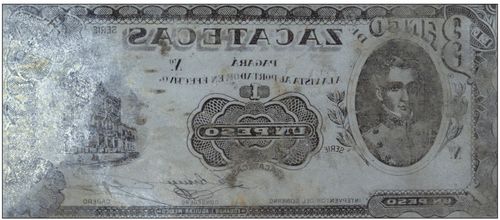
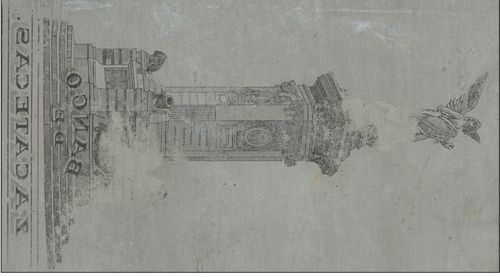
The plate has the engraved signatures of Cayetano Arteaga as Consejero and Enrique Reyes as Cajero.
Bank records state that all the finished notes were incinerated, so the image in the El Liberal article could be a photo from the lithographic plate. However, Dr. Luis Gómez Wulschner has superimposed a flipped image from the plate
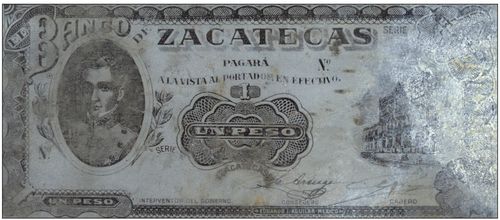
over the background colour proof
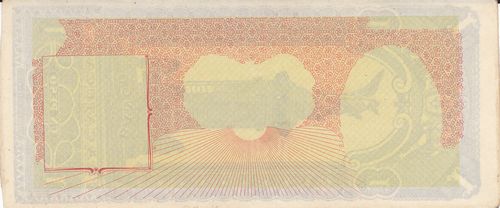
to show what the finished note will have looked like.
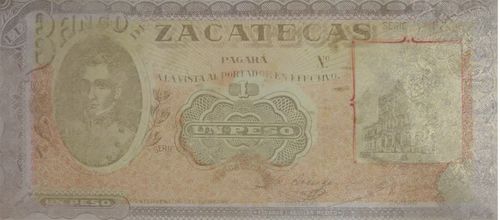
(based on “Design of the One Peso 1914 Bank of Zacatecas Note, unknown until now. Centennial Discovery!” by Dr Luis M. Gómez Wulschner with additional information from the same author)
